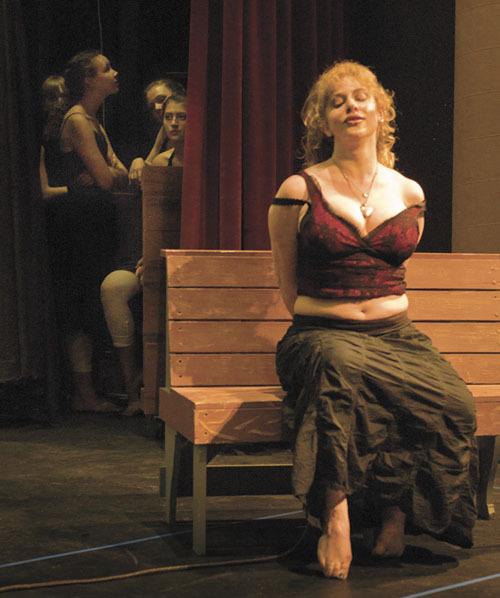It’s two weeks before opening night. In the empty high school auditorium, the cast of Vashon Opera’s production of “Carmen” has begun another lengthy rehearsal.
A few minutes into Act One, a pint-sized woman, barefoot with a voluptuous cascade of curly blonde hair, slithers quietly on stage from behind a curtain and begins to sing in a low, creamy contralto.
It’s the “Habanera,” the signature aria for the character Carmen. One of those melodies that even people who have never been to an opera instantly recognize. And Jennifer Hines, who has flown from her home in New York to sing the title role of the high-spirited gypsy in the Vashon production, is making the most of it.
In dark, languid tones, Hines sings about Carmen’s highly personal definition of love. She flirts with various males on stage. Then, to drive the point home, she plucks a soapy sponge from a pail and with head tossed back, slowly and sensuously squeezes rivulets of water over her bare shoulders.
The answers to two questions are immediately obvious. Why puritanical Paris audiences were shocked to the core when “Carmen” debuted in 1875. And second, why more than a century later, composer Georges Bizet stands vindicated, with “Carmen” one of the most performed, and most revered, of all operas.
It’s the Carmen factor. “Jennifer absolutely embodies the character,” says James Brown, who is both stage and music director for the Vashon production. “She shakes us out of our conception of how people behave. When she walks on stage, she absolutely transfixes the attention of the audience.”
While supported by a veteran cast of Northwest opera performers, Hines is this production’s certified star. Her credits include New York’s Metropolitan Opera and appearances with opera companies and orchestras throughout the United States.
Hines is singing here because of long-standing friendships with Vashon Opera’s artistic director Jennifer Krikawa and also with Brown, who heads the vocal studies and opera program at Pacific Lutheran University and has an active singing career as well. Hines and Brown were fellow students at New York’s Julliard School in the mid-1990s and performed together at the Aspen Music Festival.
Hines, a Long Island, New York, native, knows the Northwest well. Seattle Opera helped jump start her career by selecting her in 1998 for its Young Artists program. Next May, Hines returns to sing the demanding role of Suzuki in Seattle Opera’s “Madama Butterfly.”
As for Carmen, Hines has sung the role often and might be suspected of treating her Vashon appearance as a busman’s holiday. Absolutely not, she insisted in a discussion on a recent afternoon.
For one thing, Hines says she relishes the opportunity to sing in small halls with the audience up close and personal. “You can actually see the twitch in someone’s face,” she says. “For a performer, that’s pretty special.”
Equally important to Hines is the creative collaboration with Brown and Krikawa that makes this production unusual in several respects.
Traditionally, Carmen is portrayed as a tempestuous vamp who steals the heart of hapless Don José and then callously dumps him for the handsome and haughty bullfighter, Escamillo. He’s the guy who sings the famous “Toreador Song.”
But Hines and Brown have conceived an equally valid interpretation that has the two leading characters in a genuine love match from beginning to end.
Tenor Stephen Rumph, singing the role of Don José, likes the idea. Rumph thinks about this sort of thing a lot, since he’s also a music history professor at the University of Washington. “They’re inseparable,” he says of Carmen and José in the Vashon interpretation. “They’re soul mates.”
Even in the death scene, one of the great finales in all of opera. “People will be weeping,” Hines predicts.
Other out-of-the-ordinary aspects of this production: The opera is staged partially in the round. Forty chorus members sing their entire parts from the stands of a bullring. The action on stage is left almost entirely to the principal singers plus five Vashon High School students — Katherine Misel, Maeve Haselton, Mara Drape, Meg Sayre and Camille Kappelman — who have been given major dance roles by choreographer Christine Juarez, dance director at Vashon Allied Arts.
“I asked them to smoke cigarettes (unlighted, to be sure), drink and fight on stage,” says Juarez of the young dancers. “It’s a stretch and they’re really maturing in this production.”
There’s also a chorus of 13 street urchins, all Island children, who sing in French and mock the soldiers with their own parade.
Finally, the music. Traditionally performed in opera houses with a full orchestra, Vashon’s small performance space dictated cutting the musicians to five: piano, violin, cello, trumpet and flute. This required Brown to re-orchestrate Bizet’s entire score for these five instruments. No small task.
Hines’ thoughts as opening night nears? “I’ve sung Carmen 10 times, and I’ve honestly never seen it performed or interpreted with this kind of thought behind it. It’s pretty amazing.”
— Eugene Carlson is a former reporter, columnist and editor at The Wall Street Journal. He’s a chorus member in “Carmen.”
“Carmen” will be performed at 8 p.m. Friday, Sept. 16, and 2:30 p.m. Sunday, Sept. 18, at the Vashon High School theater. Tickets, $32, are on sale at www.vashonopera.org and at local bookstores. A student/family dress rehearsal will be at 7 p.m. Wednesday, Sept. 14. Tickets for the rehearsal are $15.



